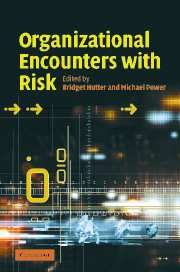Book contents
- Frontmatter
- Contents
- List of tables
- Notes on contributors
- Acknowledgements
- List of abbreviations and acronyms
- 1 Organizational encounters with risk: an introduction
- 2 Organizational rituals of risk and error
- 3 ‘Ways of seeing’: understandings of risk in organizational settings
- 4 Risk and rules: the ‘legalization’ of medicine
- 5 Organizational responses to risk: the rise of the chief risk officer
- 6 Incentives, risk and accountability in organizations
- 7 Mathematizing risk: models, arbitrage and crises
- 8 Interdependencies within an organization
- 9 Restoring reason: causal narratives and political culture
- Bibliography
- Name index
- Subject index
1 - Organizational encounters with risk: an introduction
Published online by Cambridge University Press: 22 September 2009
- Frontmatter
- Contents
- List of tables
- Notes on contributors
- Acknowledgements
- List of abbreviations and acronyms
- 1 Organizational encounters with risk: an introduction
- 2 Organizational rituals of risk and error
- 3 ‘Ways of seeing’: understandings of risk in organizational settings
- 4 Risk and rules: the ‘legalization’ of medicine
- 5 Organizational responses to risk: the rise of the chief risk officer
- 6 Incentives, risk and accountability in organizations
- 7 Mathematizing risk: models, arbitrage and crises
- 8 Interdependencies within an organization
- 9 Restoring reason: causal narratives and political culture
- Bibliography
- Name index
- Subject index
Summary
Organizing and risking
Contemporary discussions of risk routinely point to the paradox of science and technology. On the one hand great advances have been made in health and welfare; on the other hand such advances also give rise to new problems and vulnerabilities, e.g. the benefits of increased longevity in Western societies have given rise to difficulties in pension and social security systems. This is the essence of Beck's (1992) famous ‘risk society’ thesis; the risks we face today are largely ‘manufactured’, potentially fatal by-products of an industrial machine which demands a new politics to control it. In this collection of essays, we retain a focus on this paradox but we shift the analytical focus from science and technology to organizations and organizing.
Organizations, rather than individuals, are the critical agents of any so-called risk society because it is primarily ‘in these contexts that hazards and their attendant risks are conceptualized, measured and managed’ (Short 1992: 4). Organizations are both centres for processing and handling risks and potential producers and exporters of risk. Efforts to manage risk involve the creation of organizational networks for that purpose, and these risk regulation ‘regimes’ (Hood et al. 2001) themselves give rise to new side effects and risks – risks of risk management. Above all, there is widespread recognition that disasters and accidents are in a very important sense organized (cf. Beamish 2002; Perrow 1984; Turner and Pidgeon 1997; Vaughan 1996).
- Type
- Chapter
- Information
- Organizational Encounters with Risk , pp. 1 - 32Publisher: Cambridge University PressPrint publication year: 2005
- 16
- Cited by



